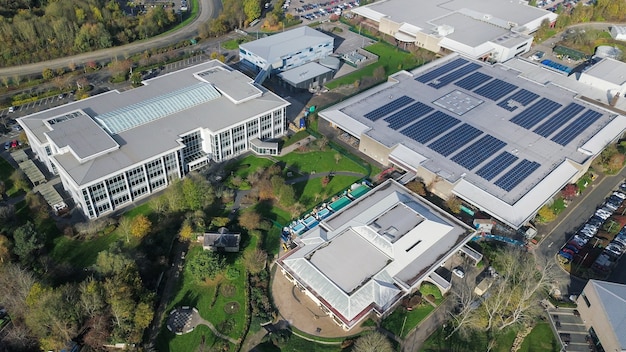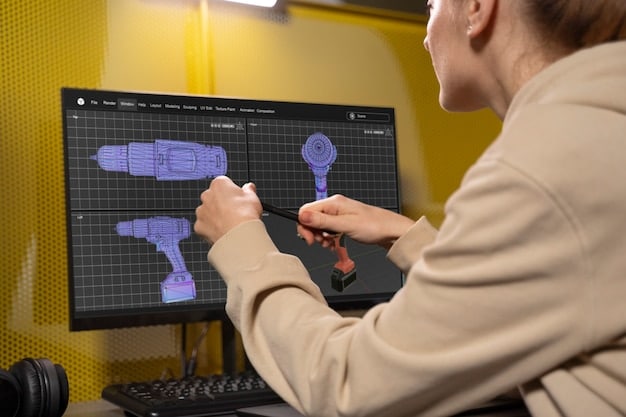Reducing Carbon Footprint: Circular Economy for US Manufacturers

US manufacturers can significantly reduce their carbon footprint by adopting circular economy principles such as resource efficiency, waste reduction, remanufacturing, and product life extension, fostering sustainability and environmental responsibility.
The manufacturing sector in the United States is a significant contributor to the nation’s carbon footprint. However, by embracing the principles of a circular economy, US manufacturers can dramatically reduce their environmental impact and enhance their competitiveness. Let’s explore how.
Understanding the Circular Economy
The circular economy represents a paradigm shift from the traditional linear “take-make-dispose” model to one that is regenerative and restorative. It aims to minimize waste and make the most of resources by keeping products and materials in use for as long as possible.
For US manufacturers, adopting a circular economy involves rethinking their entire value chain, from product design and sourcing to manufacturing processes and end-of-life management. This transition requires a holistic approach that considers environmental, economic, and social factors.
Resource Efficiency and Waste Reduction
One of the most straightforward ways for US manufacturers to reduce their carbon footprint is by improving resource efficiency and minimizing waste. This involves optimizing production processes to use fewer raw materials, water, and energy.
Implementing strategies such as lean manufacturing, waste stream mapping, and closed-loop systems can help identify and eliminate inefficiencies, reduce waste generation, and lower greenhouse gas emissions.
Implementing Lean Manufacturing
Lean manufacturing focuses on eliminating waste in all its forms, from excess inventory to unnecessary motion. By streamlining production processes, manufacturers can reduce energy consumption and material waste.
Waste Stream Mapping
Waste stream mapping involves tracking the flow of materials and waste throughout the manufacturing process. This helps identify opportunities for waste reduction, reuse, and recycling.
- Optimize production processes to reduce material usage.
- Implement closed-loop systems for water and chemical usage.
- Recycle or repurpose waste materials whenever possible.
- Invest in energy-efficient equipment and technologies.
By prioritizing resource efficiency and waste reduction, US manufacturers can significantly lower their carbon footprint and improve their bottom line.
Designing for Circularity
Product design plays a crucial role in enabling a circular economy. Designing products for durability, repairability, and recyclability can extend their lifespan and reduce the demand for new resources.
Manufacturers can also incorporate recycled materials into their products, reducing their reliance on virgin resources and lowering the embodied carbon footprint of their goods.

Durability and Repairability
Designing products to be durable and easily repairable ensures they last longer and require fewer replacements. This reduces the overall demand for new materials and energy.
Recycled Materials Integration
Using recycled materials in the manufacturing process lowers the need for virgin resources. Consider the reduction in energy consumption and emissions associated with mining and processing new materials.
- Design products with modular components that can be easily replaced or upgraded.
- Use durable and high-quality materials to extend product lifespan.
- Incorporate recycled materials into product design whenever possible.
- Provide clear instructions and resources for product repair and maintenance.
By designing for circularity, US manufacturers can create products that are both environmentally friendly and economically viable.
Remanufacturing and Refurbishment
Remanufacturing and refurbishment involve restoring used products to like-new condition. These processes extend the lifespan of products, reduce waste, and conserve resources.
Remanufacturing typically involves completely disassembling and rebuilding a product, while refurbishment focuses on repairing or replacing worn parts. Both strategies offer significant environmental and economic benefits.
The Remanufacturing Process
Benefits of Refurbishment
Refurbishing products is less intensive than remanufacturing. It typically entails repairing defective products or replacing worn ones for resale or reuse.
Investing in remanufacturing and refurbishment programs creates more sustainable business models.
By embracing these practices, US manufacturers can tap into new revenue streams and reduce their environmental footprint.
Product Life Extension Strategies
Extending product life is a key principle of the circular economy. Manufacturers can achieve this through various strategies, including offering repair services, providing software updates, and designing products with upgradable components.
Companies like Patagonia have demonstrated the value of product life extension through their repair programs and durable products.
Manufacturers can benefit from extending product lifecycles, and consumers can retain products they trust rather than buy new ones with software.
Consider the benefits, such as fewer resources needed to create new products, and emissions declines, creating a healthier planet.
Collaboration and Partnerships
Transitioning to a circular economy requires collaboration and partnerships across the value chain. This includes suppliers, manufacturers, retailers, and consumers.
By working together, stakeholders can share knowledge, resources, and best practices to accelerate the adoption of circular economy principles.

Sharing resources ensures a more environmentally friendly system of industry.
Working together ensures better practices that everyone benefits from.
Supply chain transparency reveals inefficiencies across the board.
Working with waste management companies ensures you’re not only creating less waste but managing it properly.
Sharing knowledge throughout the supply chain allows for innovation and new ideas.
By fostering collaboration and partnerships, US manufacturers can collectively drive the transition to a more circular economy.
Policy and Regulatory Support
Government policies and regulations can play a crucial role in promoting the circular economy. Incentives, standards, and extended producer responsibility (EPR) schemes can encourage manufacturers to adopt more sustainable practices.
US policymakers are increasingly recognizing the importance of the circular economy and are exploring various policy options to support its growth.
Government requirements establish an industry standard across supply chains, pushing businesses to operate ethically.
Standardized metrics allow the success of sustainable efforts to be measured.
By advocating for supportive policies and regulations, US manufacturers can help create a level playing field and accelerate the transition to a circular economy.
♻️ Resource Efficiency
Streamline production to minimize waste and resource consumption.
🛠️ Design for Durability
Create products that last longer and are easy to repair.
🔄 Remanufacturing
Restore used products to “like-new” condition, extending their life.
🤝 Collaboration
Partner across the value chain for innovation and shared goals.
What are the key principles of the circular economy?
The circular economy focuses on reducing waste and utilizing resources for as long as possible by reusing, repairing, and recycling them into new products.
How can manufacturers design for circularity?
Manufacturers can design products with durability, repairability, and recyclability in mind to extend their lifespan and reduce resource consumption.
What is remanufacturing, and how does it benefit manufacturers?
Remanufacturing restores used products to a like-new condition and reduces waste, creating viable revenue streams.
How do collaboration and partnerships support the circular economy?
Sharing knowledge, resources, and best practices results from collaborations. This accelerates the adoption of these principles.
What is the role of government policy in advancing the circular economy?
Government incentives encourage manufacturers to adapt practices by complying with ethical guidelines.
Conclusion
Adopting circular economy principles offers US manufacturers a powerful pathway to reduce their carbon footprint and enhance their competitiveness. By prioritizing resource efficiency, designing for circularity, embracing remanufacturing and refurbishment, extending product life, fostering collaboration, and advocating for supportive policies, US manufacturers can drive the transition to a more sustainable and resilient economy.
Read more content





